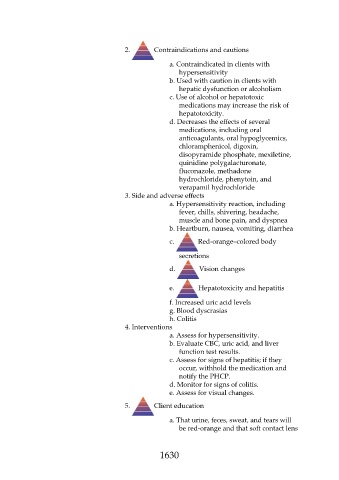Page 1630 - Saunders Comprehensive Review For NCLEX-RN
P. 1630
2. Contraindications and cautions
a. Contraindicated in clients with
hypersensitivity
b. Used with caution in clients with
hepatic dysfunction or alcoholism
c. Use of alcohol or hepatotoxic
medications may increase the risk of
hepatotoxicity.
d. Decreases the effects of several
medications, including oral
anticoagulants, oral hypoglycemics,
chloramphenicol, digoxin,
disopyramide phosphate, mexiletine,
quinidine polygalacturonate,
fluconazole, methadone
hydrochloride, phenytoin, and
verapamil hydrochloride
3. Side and adverse effects
a. Hypersensitivity reaction, including
fever, chills, shivering, headache,
muscle and bone pain, and dyspnea
b. Heartburn, nausea, vomiting, diarrhea
c. Red-orange–colored body
secretions
d. Vision changes
e. Hepatotoxicity and hepatitis
f. Increased uric acid levels
g. Blood dyscrasias
h. Colitis
4. Interventions
a. Assess for hypersensitivity.
b. Evaluate CBC, uric acid, and liver
function test results.
c. Assess for signs of hepatitis; if they
occur, withhold the medication and
notify the PHCP.
d. Monitor for signs of colitis.
e. Assess for visual changes.
5. Client education
a. That urine, feces, sweat, and tears will
be red-orange and that soft contact lens
1630

